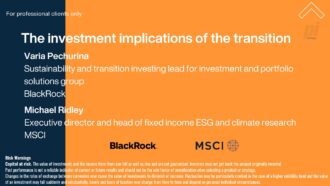“There is room for other players to step in as banks deleverage and get rid of core loans,” he said. “A more diverse system can be good and more resilient.”
Dempster said banks’ decision to deleverage and concentrate on their “core business” was a euphemism for them “getting out of derivatives” which would also create opportunities in alternative lending.
He added some 40,000 small and medium enterprises had been sold overlay swaps they did not need and there was currently around $3trn of unhedged derivatives in the marketplace.
Küller said banks in the EU had so far disposed of just €100bn of non-core loans out of a total book of some €2.4trn, meaning there was still a huge amount on the balance sheet to shift.
Mercer director of private debt Sanjay Mistry agreed, saying so far “just billions” rather than “thousands of billions” had entered into this market from investors. “It’s hard to see where a trillion would come from”, he added.
Mistry also said the alternative credit market would open up in the next five years as regulators prevented banks taking the same level of risk, but added we had not yet seen European capital markets open up as they have in the US. “The institutional sector is not geared up to do all the lending; many institutional portfolios are not open to this world,” he said. “The longer term solutions are not really around.”
He warned however, it would be difficult to “get thousands of loans together”, so asset managers would find it difficult to build a portfolio that is risk diversified enough for institutional investors.
Küller summed up the discussion, saying: “Banks are OK with being the bad guys so will not lend. From a portfolio perspective, I am confident there will be opportunities for institutional investors.”
Illiquidity issues
Investors should be increasing their exposure to illiquid credit while yields from tradtional forms of debt remain so poor, delegates heard.
Speaking during the illiquidity panel discussion, Telereal Trillium pensions manager Ben Shaw explained how his fund began investing in high yield bonds, asset-backed securities (ABS) and direct lending after becoming disillusioned by more traditional forms of fixed income.
Elsewhere, Islington Pension Fund sub-committee chairman Richard Greening said investors needed to assess their appetite and ability to take on illiquidity, but said there was a widespread risk of over-exposure to equities. “You have to question whether an equity strategy is what you want to pursue,” he added. “There is an issue the advice that comes to pension funds is too conservative for fear of repercussions.”
Greening also warned against short-term decisionmaking resulting from quarterly reporting. He said his fund had a £300m liability over 40 years and “did not need a return tomorrow” allowing it accept more illiquidity. “We are looking at alternatives – property and residential property.”
There was widespread agreement that investors could take on more illiquidity risk – as much as 10-times current levels in some cases, claimed Mercer’s Sanjay Mistry – but many funds faced governance hurdles.




Comments